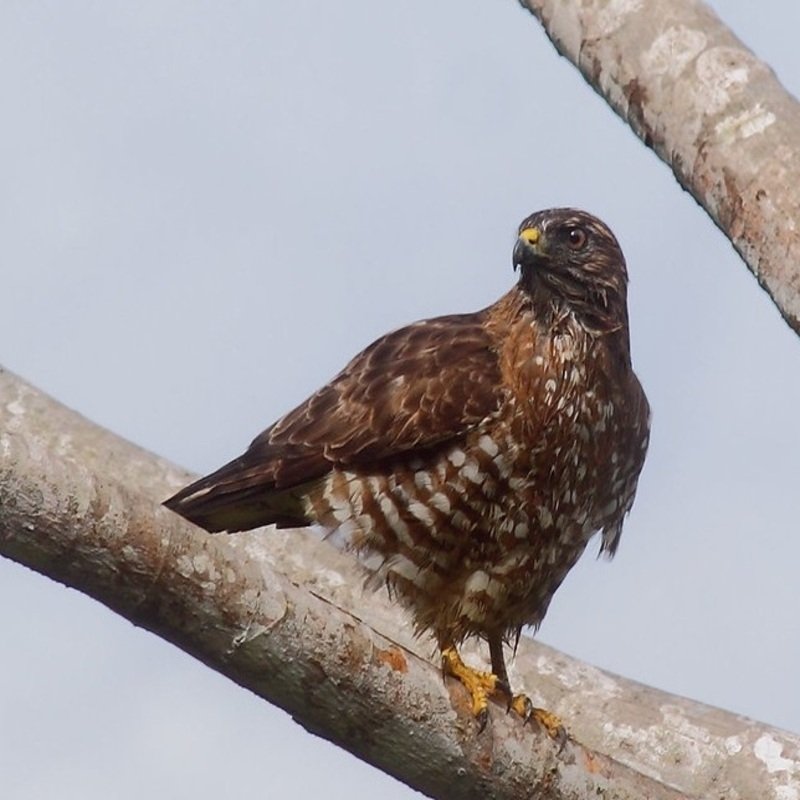Buteo platypterus, known to be a Broad-winged hawk, in the Neotropics from Mexico to southern Brazil. Some subspecies live year-round on Caribbean islands. Females are bigger than males in most raptors. Wide-winged hawks have short, broad wings with a tapering, pointed tip. In addition to the two coloring kinds, there are also two morphs: dark and light. Although broad-winged hawk numbers remain steady, forest fragmentation is reducing populations in some areas.
Quick Overview: Buteo Platypterus – Broad-Winged Hawk
Body size: Around13-19 in (33-48 cm) and a weight of 419 g (17.8 oz)
Main colors: Brown, Chestnut, White
Range: Eastern United States
Migratory Bird: Yes
Best time of the year to see in the U.S.: June, July, August, September
Conservation Status: Least Concern
Broad-winged hawk Description
Small, stocky Broad-winged Hawks, they are 34-44 cm long and 265-560 g. Their wingspan is 81-100 cm. Adults have a dark brown back and a light belly with horizontal cinnamon or chestnut barring. On the tail are a prominent broad white stripe in the center and two less prominent white stripes at the base and tip. Broad-winged hawks fly with pointed wingtips. They don’t have wings that reach the end of their tails when perched.

Size
These hawks have a length of 13-19 in (33-48 cm) and a weight of 419 g (17.8 oz). Their wings could range from 32-39 in (81-99 cm).
Feeding
Broad-winged hawks eat meat. Their food varies seasonally and includes insects, amphibians, reptiles, mammals, and birds. Frogs, lizards, and breeding birds are popular food items during the nesting season. An insect-based diet is consumed in the winter. Meat is eaten whole. Skinned frogs and snakes, plucked birds
Habitat
This species prefers thick deciduous or coniferous woodlands to nest. They enjoy open spaces like highways, trails, marshes, and meadows. Foraging Broad-winged Hawks exploit these canopy openings. They avoid breeding near human homes.
Behavior
Except when migrating, broad-winged hawks are alone. This is one of North America’s rare flocking raptors. During migration, flocks (called kettles) can reach tens of thousands. Other raptors may join these flocks. Broad-winged hawks, like many hawks, can soar. They employ thermal currents to migrate, saving energy by not flapping their wings.
Buteo platypterus Scientific Classification
- Kingdom: Animalia
- Phylum: Chordata
- Subphylum: Chelicerata
- Class: Aves
- Order: Accipitriformes
- Family: Accipitridae
- Genus: Buteo
- Species: Buteo platypterus
Subspecies
This species, Buteo platypterus, belongs in the family Accipitridae, which is classified in the order Falconiformes (or Accipitriformes) (or Accipitriformes). Currently, the species is divided into six subspecies; each is named for its distribution.
Best time of the year to see
The best time to see these birds in the United States is during the summer season (June – September).
Distribution of the Broad-winged hawk in the USA
Broad-winged hawks are endemic to the Nearctic and Neotropical areas. They breed in the eastern United States and most of southern Canada. Their winter range includes southern Florida, the Pacific coast of southern Mexico, Central America, and northern South America.
The Broad-winged hawk can be found in the following states in the United States – Alabama, Arkansas, Connecticut, Delaware, Georgia, Hawaii, Illinois, Indiana, Iowa, Kansas, Kentucky, Louisiana, Maine, Maryland, Massachusetts, Michigan, Minnesota, Mississippi, Missouri, Nebraska, New Hampshire, New Jersey, New York, North Carolina, North Dakota, Ohio, Oklahoma, Pennsylvania, Rhode Island, South Carolina, South Dakota, Tennessee, Vermont, Virginia, West Virginia, and Wisconsin.
